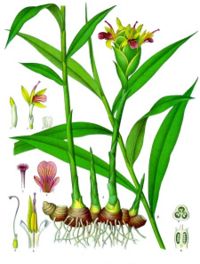Zingiber
Zingiber {{{latin_name}}}
|
Ginger
| ||||||||||||||||||||||||||||||||||||||||
|---|---|---|---|---|---|---|---|---|---|---|---|---|---|---|---|---|---|---|---|---|---|---|---|---|---|---|---|---|---|---|---|---|---|---|---|---|---|---|---|---|---|

|
|
| |||||||||||||||||||||||||||||||||||||||
| |||||||||||||||||||||||||||||||||||||||||
About 60 species exist in the ginger (Zingiberaceae) family, but the only one we commonly eat is the rhizome of Zingiber officinale. The herbaceous and evergreen rhizomatous plants form clumps. They are perennial herbs. Leaves are normally narrow and arranged in 2 ranks on upright stems. Blooms are often very bright colors and appear cone-like, with the waxy-looking bracts overlapping. These inflorescences rise from the plant's base in summer. The majority are frost tender, though some do well in temperate gardens.
Cultivation
| Zingiber calendar? | ||
|---|---|---|
| January: | ||
| February: | ||
| March: | divide | |
| April: | divide | |
| May: | ||
| June: | ||
| July: | ||
| August: | ||
| September: | ||
| October: | ||
| November: | ||
| December: | ||
| Notes: | ||
Most like nutrient-rich, moist soil with good drainage, and full to part shade. They like a warm, humid climate.
Propagation
Most are easily propagated by division in early spring.
Pests and diseases
Species
Approx 60 species, including: Z. cochleariforme - Z. ellipticum - Z. emeiense - Z. guangxiense - Z. gulinense - Z. kawagoii - Z. leptorrhizum - Z. liangshanense - Z. lingyunense - Z. longyangjiang - Z. macradenium - Z. mioga - Z. mongalense - Z. montanum - Z. nudicarpum -Z. officinale - Z. sichuanense - Z. spectabile - Z. sylvaticum - Z. tuanjuum - Z. zerumbet
Gallery
-
photo 1
-
photo 2
-
photo 3
References
- Flora: The Gardener's Bible, by Sean Hogan. Global Book Publishing, 2003. ISBN 0881925381
External links
- w:Zingiber. Some of the material on this page may be from Wikipedia, under the Creative Commons license.
- Zingiber QR Code (Size 50, 100, 200, 500)
